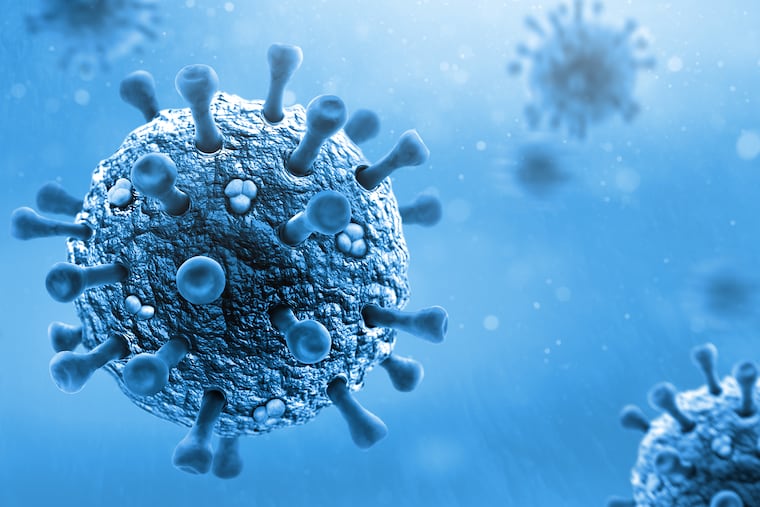New COVID variant drives increase in Pa. and N.J. infections
COVID experts expressed concern, but not alarm, over the latest variant quickly becoming dominant in the United States.

COVID-19 cases in Pennsylvania and New Jersey increased after the winter holidays as the latest variant of the virus becomes more prevalent in the region, data show.
A new omicron subvariant, XBB.1.5, appears to be more transmissible than earlier forms of COVID and as of the end of December accounted for more than 32% of the cases in the region that includes Pennsylvania. It is far more common in New York and New Jersey, where it accounts for 72% of cases, according to the Centers for Disease Control and Prevention.
Nationally, COVID cases are down slightly compared with two weeks ago, according to the New York Times’ COVID tracker, though hospitalizations rose 12% in the same time frame. More than 450 Americans a day are dying of the virus.
While cases rose in Pennsylvania, they declined in Philadelphia. Still, public health experts are concerned about the new variant, which is spreading fast locally, said Frederic Bushman, chair of microbiology at the University of Pennsylvania’s Perelman School of Medicine and codirector of the Penn Center for Research on Coronavirus and Other Emerging Pathogens, which conducts genetic sequencing on COVID samples in the region.
“It is sharply increasing as a proportion of all infections,” he said, “and we are seeing an uptick in measures of new infections.”
The new variant is more immune-evasive and appears to be resistant to one of the more common monoclonal antibody treatments prescribed for people with COVID, Bushman said.
In a series of tweets Wednesday, Ashish Jha, the White House COVID response coordinator, described the variant as spreading at a “stunning” rate. Just a few weeks ago, he said, XBB.1.5 accounted for just 4% of the country’s COVID cases. Now it causes about 40% of cases. It’s unclear whether XBB.1.5 causes more severe illness than other variants, Jha said.
“If you had an infection before July OR your last vaccine was before bivalent update in September,” Jha tweeted, “your protection against an XBB.1.5 infection is probably not that great.”
Nationally, just 15% of Americans 5 or older received a dose of the bivalent booster dose.
Those who are vaccinated, have had previous infections, or both, but haven’t received the bivalent vaccine, won’t be defenseless, Bushman said.
Throughout the pandemic, new variants that are more transmissible and more immune resistant have consistently outperformed earlier strains of the virus, but have still been similar enough that the vaccines prevent serious illness and death.
“I haven’t seen anything particularly worrisome,” said Paul Offit, codirector of the Vaccine Education Center at Children’s Hospital of Philadelphia, and a member of the Food and Drug Administration’s advisory board on vaccination. “XBB.1.5 is a derivative of BA.2. In other words, we are still in the world of omicron subvariants.”
An Atlantic article this week noted the new variant is not yet showing clear signs of causing a significant increase in hospitalizations.
Existing COVID tests are effective at detecting the new variant, Jha said, and the most common oral treatments, Paxlovid and Molnupiravir, will continue to work.
Jha encouraged people to mask while visiting crowded indoor spaces and to test before seeing vulnerable relatives.
“So am I concerned about XBB.1.5? Yes,” Jha tweeted. “Am I worried this represents some huge setback? No. We can work together to manage the virus.”
» READ MORE: Visit our COVID tracker to see more data
Here’s a look at this week’s COVID numbers:
Pa. COVID cases and transmission
Daily average cases: 2,246
Case rate rise/fall over 14 days: +8%
Daily average hospitalizations: 2,070
Hospitalizations rate rise/fall over 14 days: +16%
Total deaths: 49,034
Philly COVID cases and transmission
Daily average cases: 192
Case rate rise/fall over 14 days: -9%
Daily average hospitalizations: 303
Hospitalizations rate rise/fall over 14 days: -17%
Total deaths: 5,430 (as of Jan. 2)
N.J. COVID cases and transmission
Daily average cases: 3,046
Case rate rise/fall over 14 days: +13%
Daily average hospitalizations: 1,644
Hospitalizations rate rise/fall over 14 days: +7%
Total deaths: 35,601
Data Sources: New York Times COVID data tracker; New Jersey and Pennsylvania Departments of Health. Numbers are updated as of Wednesday, Jan. 4.